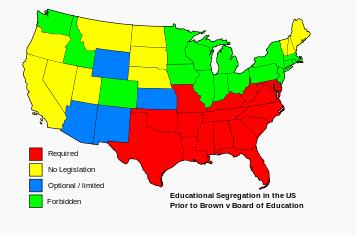
Segregation and integration of Education in the United State
WIKIPEDIA | 2014-05-22 14:17

Segregation laws in the United States prior to Brown v. Board of Education
For much of its history, education in the United States was segregated (or even only available) based upon race. Early integrated schools such as the Noyes Academy, founded in 1835, in Canaan, New Hampshire, were generally met with fierce local opposition. For the most part, African Americans received very little to no formal education before the Civil War. Some free blacks in the North managed to become literate.In the South where slavery was legal, many states had laws prohibiting teaching enslaved African Americans to read or write. A few taught themselves, others learned from white playmates or more generous masters, but most were not able to learn to read and write. Schools for free people of color were privately run and supported, as were most of the limited schools for white children. Poor white children did not attend school. The wealthier planters hired tutors for their children and sent them to private academies and colleges at the appropriate age.
During Reconstruction a coalition of freedmen and white Republicans in Southern state legislatures passed laws establishing public education. The Freedmen's Bureau was created as an agency of the military governments that managed Reconstruction. It set up schools in many areas and tried to help educate and protect freedmen during the transition after the war. With the notable exception of the desegregated public schools in New Orleans, the schools were segregated by race. By 1900 more than 30,000 black teachers had been trained and put to work in the South, and the literacy rate had climbed to more than 50%, a major achievement in little more than a generation.
Many colleges were set up for blacks; some were state schools like Booker T. Washington's Tuskegee Institute in Alabama, others were private ones subsidized by Northern missionary societies.
Although the African-American community quickly began litigation to challenge such provisions, in the 19th century Supreme Court challenges generally were not decided in their favor. The Supreme Court case of Plessy v. Ferguson (1896) upheld the segregation of races in schools as long as each race enjoyed parity in quality of education (the "separate but equal" principle). However, few black students received equal education. They suffered for decades from inadequate funding, outmoded or dilapidated facilities, and deficient textbooks (often ones previously used in white schools).
Starting in 1914 and going into the 1930s, Julius Rosenwald, a philanthropist from Chicago, established the Rosenwald Fund to provide seed money for matching local contributions and stimulating the construction of new schools for African American children, mostly in the rural South. He worked in association with Booker T. Washington and architects at Tuskegee University to have model plans created for schools and teacher housing. With the requirement that money had to be raised by both blacks and whites, and schools approved by local school boards (controlled by whites), Rosenwald stimulated construction of more than 5,000 schools built across the South. In addition to Northern philanthrops and state taxes, African Americans went to extraordinary efforts to raise money for such schools.
The Civil Rights Movement of the 1950s and 1960s helped publicize the inequities of segregation. In 1954, the Supreme Court in Brown v. Board of Education unanimously declared that separate facilities were inherently unequal and unconstitutional. By the 1970s segregated districts had practically vanished in the South.
Integration of schools has been a protracted process, however, with results affected by vast population migrations in many areas, and affected by suburban sprawl, the disappearance of industrial jobs, and movement of jobs out of former industrial cities of the North and Midwest and into new areas of the South. Although required by court order, integrating the first black students in the South met with intense opposition. In 1957 the integration of Central High School in Little Rock, Arkansas, had to be enforced by federal troops. President Dwight D. Eisenhower took control of the National Guard, after the governor tried to use them to prevent integration. Throughout the 1960s and 1970s, integration continued with varying degrees of difficulty. Some states and cities tried to overcome de facto segregation, a result of housing patterns, by using forced busing. This method of integrating student populations provoked resistance in many places, including northern cities, where parents wanted children educated in neighborhood schools.
Although full equality and parity in education has still to be achieved (many school districts are technically still under the integration mandates of local courts), technical equality in education had been achieved by 1970.
Share this page



















